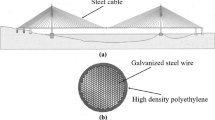Abstract
Quantitative evaluation of the steel corrosion in cables is significant for the safe operation of cable-supported bridges. The magnetic flux (MF) examination shows great potential to detect the corrosion defect, or loss of metallic cross-sectional area (LMA). An LMA defect in steel cables can be measured accurately when it is longer than a certain length. However, for defects in early stage, where the length of corrosion area is short, the MF examination may produce unacceptable error. In this study, the effect of defect length on the MF examination for corrosion detection of bridge cables is investigated through theoretical analysis and model experiments. An original analytical model to quantify the influence of defect length is proposed based on the equivalent magnetic circuit method. Then, MF examination experiments are performed on a series of cable models with different defect lengths and locations to verify the analytical model. Further, parameter study is conducted based on the proposed analytical model to clarify the mechanism of the defect-length effect. The results show that the area loss caused by short corrosion damage will be underestimated if the defect-length effect is neglected, and this effect can be quantified efficiently with the proposed analytical model.
Similar content being viewed by others
References
Mcgogney C H, Landis E N. Magnetic flux leakage for bridge inspection. In: Nondestructive Testing Methods for Civil Infrastructure. New York: American Society of Civil Engineers, 1995, 31–44
Ebeling R M, White B C, Strom R W, Hite J, John E. Assessing Corrosion Damage and Corrosion Progression in Multistrand Anchor Systems in Use at Corps Projects. US Army Corps of Engineers, Report No. ERDC TR-13–3. 2013
Wu X J, Yuan J M, Ben A R. A novel magnetic testing method for the loss of metallic cross-sectional area of bridge cables. International Journal of Applied Electromagnetics and Mechanics, 2012, 39(1): 195–201
Park S, Kim J, Lee C, Lee J J. Magnetic flux leakage sensing-based steel cable NDE technique. Shock and Vibration, 2014, 2014(2): 1–8
Dost Y, Apaydın N, Dedeoğlu E, Mackenzie D K, Akkol O Z. Nondestructive Testing of Bosphorus Bridges. In: Nondestructive Testing of Materials and Structures, Springer, 2013, 819–825
Kitagawa M, Suzuki S, Okuda M. Assessment of cable maintenance technologies for Honshu-Shikoku Bridges. Journal of Bridge Engineering, 2001, 6(6): 418–424
Liu X, Wang Y, Wu B, Gao Z, He C. Design of tunnel magnetoresistive-based circular MFL sensor array for the detection of flaws in steel wire rope. Journal of Sensors, 2016, 2016: 1–8
Reimund V, Pelkner M, Kreutzbruck M, Haueisen J. Sensitivity analysis of the non-destructive evaluation of micro-cracks using GMR sensors. NDT &E International, 2014, 64: 21–29
Weischedel H R, Hoehle H. Quantitative nondestructive in-service evaluation of stay cables of cable-stayed bridges: methods and practical experience. In: Proc. SPIE 2456, Nondestructive Evaluation of Aging Bridges and Highways, 1995
Weischedel H R. Electromagnetic wire rope inspection-resolution is important. Materials Evaluation, 1998, 56(11): 1297–1301
Zhang Q W, Xin R Y, Ji Y F. Corrosion detection for steel wires in bridge cables using magnetic method. In: IABSE Conference Nara 2015, Nara, 2015, Article ID: SS–1
Hamelin M, Kitzinger F. Apparatus for increasing linear resolution of electromagnetic wire rope testing. United States Patent No. 5,565,771
Weischedel H R. Electromagnetic wire rope inspection: signal generation, filtering and computer-aided rope evaluation. In: OIPEEC Technical Meeting on the Non-destructive Testing of Rope, Krakow, Poland, 1999, 91–104
The University Of Reading. Wire Rope Non-destructive Testing-Survey of Instrument Manufacturers. OFFSHORE TECHNOLOGY REPORT-OTO 2000 064. 2000
Jomdecha C, Prateepasen A. Design of modified electromagnetic main-flux for steel wire rope inspection. NDT & E International, 2009, 42(1): 77–83
Xu F, Wang X, Wu H. Inspection method of cable-stayed bridge using magnetic flux leakage detection: principle, sensor design, and signal processing. Journal of Mechanical Science and Technology, 2012, 26 (3): 661–669
Yuan J M. Measurement Methods for Metal Cross-sectional Area of in-service Cables. Dissertation for the Doctoral Degree. Wuhan: Huazhong University of Science & Technology, 2012 (in Chinese)
Geller L B, Rousseau G. Effect of Trapped Wire Rope Debris upon an EM Instrument’s LMA Chart Trace. CANMET INFORMATION CENTER, Research Report No. MRL 90–008 (TR). 1990
Rumiche F, Indacochea J E, Wang M L. Detection and monitoring of corrosion in structural carbon steels using electromagnetic sensors. Journal of Engineering Materials and Technology, 2008, 130(3): 635–644
General Administration of Quality Supervision, Inspection and Quarantine of the People’s Republic of China. Technical Conditions for Hot-Extruding PE Protection High Strength Wire Cable of Cable-Stayed Bridge, GB/T 18365–2001. Beijing: China Standards Press, 2001 (in Chinese)
Christen R, Bergamini A, Motavalli M. Three-dimensional localization of defects in stay cables using magnetic flux leakage methods. Journal of Nondestructive Evaluation, 2003, 22 (3): 93–101
Acknowledgements
The authors are appreciated for the financial support provided by the Ministry of Science and Technology of China (Grant No. SLDRCE14-B-23).
Author information
Authors and Affiliations
Corresponding author
Rights and permissions
About this article
Cite this article
Zhang, Q., Xin, R. The defect-length effect in corrosion detection with magnetic method for bridge cables. Front. Struct. Civ. Eng. 12, 662–671 (2018). https://doi.org/10.1007/s11709-018-0512-4
Received:
Accepted:
Published:
Issue Date:
DOI: https://doi.org/10.1007/s11709-018-0512-4



